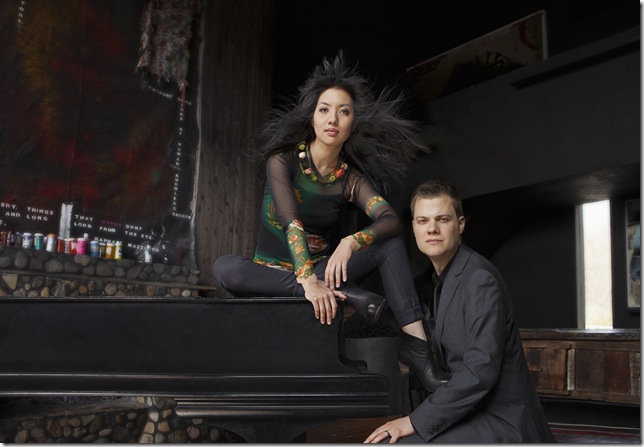I’m lucky enough to have heard three sets of piano duos in person in my lifetime: Cyril Smith and Phyllis Sellick in England; Arthur Whittemore and Jack Warren Lowe at a private concert given in honor of Alistair Cooke; and David Bradshaw and Cosmo Buono, who took Europe by storm in the 1980s with a little advice from yours truly.
The young duo of Elizabeth Joy Roe and Greg Anderson rank with the best of these, and therefore their return to the Chamber Music Society of Palm Beach on Dec. 16 was more than welcome. The artistry of Anderson and Roe is exemplary; graduates of the Juilliard School, they’ve been performing together since 2000, and their intensity of effort speaks to their youthful approach.
Opening at Mar-a-Lago with their arrangement of Schubert’s Ave Maria (the first world premiere of three that night) using four hands on one piano, they took it very slowly: a pace a singer would die for. Roe played the delicate arpeggios, Anderson staked out the melody. Of the many settings I’ve heard, this ranks among the finer ones. The melody passed to Roe as Anderson took over the constant arpeggios. Her phrasing was beautiful, and as the piece moved to double forte both gave it a warm emotional expressiveness. Winding down, it ended ethereally: A sacred interpretation suitable for this time of year.
From this point on each pianist used his or her own concert grand. The Busoni arrangement of the finale of Mozart’s Piano Concerto No. 19 (in F, K. 459) followed. They gave this familiar music fresh life. The return to the main theme and the great staccato work at the end were brilliantly interpreted.
World premiere No. 2 was next: Anderson and Roe’s arrangement of the Andante con moto movement from Beethoven’s Fifth Symphony. Anderson announced the appropriateness of the day — it was Beethoven’s 245th birthday — and almost apologized for daring to rework it for duo pianos.
At first, the music seemed to plod along at a snail’s pace. Then it began to build to the magnificent statement it is. This was indeed a daring arrangement, written with comprehension and a degree of wit. Eventually we heard the two ascending scales and fuller orchestral colors began to show. Some questionable ad libitum passages followed in the pianists’ treatment of the famous woodwind exchanges and solos. Creating this kind of sound and the double forte of the orchestra takes some. Finally, as the syncopation begins to take front and center, their playing was riveting. Quiet dotted notes signal that the boisterous ending is in sight. Four massive chords bring it to an end, and a roar of applause from the full house greeted their arrangement.
Brahms’s Variations on a Theme by Haydn (the theme is also known as the “St. Antoni Chorale”) came next. Anderson and Roe gave it a slow deliberate opening, emphasizing the St. Antoni chorale music. The first variation was played with the ringing clarity, and the second came off as smooth and pleasant as vanilla ice cream. In the fourth variation, I felt the left hand could have used some more definition, and in the sixth, I felt the melody needed more emphasis. They also took it at breakneck speed, too fast to my liking.
The seventh variation was approached all too reverently; it needs to flow along. And the playing in the finale was not up to the other seven movements. The opening scales were not cleanly deliberate and the playing of the runs in general was poor. A sense of tiredness had crept in by this point, probably because there was too much “symphonic” work earlier in the program. This is a piece one begins with.
The third world premiere was an arrangement of the Hungarian Dance No. 5 of Brahms. “We messed with it and we found new ways to re-invigorate it,’’ Anderson said, not hearing Brahms spinning in his grave. But the exuberance of youth had its way and indeed, this was an original and clever arrangement. Opening with Eastern sounds that lead to very tricky scales, the famous Brahms tune is realized. Mesmerizing weavings from one piano continue as the other pianist offers magical pianistic effects, taking apart the main tune, chord by chord. Having “messed” with the melody up until now, it appears in recognizable form for a short time as three quick chords suddenly end the piece. Huge audience acclaim met this efforts.
Astor Piazzolla’s three tango dances followed, somewhat anti-climactically. In Oblivion, Roe draws her hand over the strings as Anderson plays. This effect is used a lot by the composer.
The second dance, Primavera Porteña, is full of fire, with quick runs exquisitely played by Roe. There’s lots of crossing of hands — four hands, one piano — which imitated the crossing of legs in the sexy style of tango dancing practiced in Argentina. Libertango came last, with Anderson’s playing suppressed by Roe, who held the piano wires to stop them reverberating, achieving a fascinating dampening effect.
Ravel’s La Valse ended the program. Written in the midst of World War I when he was an ambulance driver, it rumbles into life from the depths of the keyboard. Snatches of waltz tunes appear. Roe’s delicate touch was irresistible and Anderson’s long keyboard runs were amazing.
Toes were tapping all around me; it’s so easy to get caught up in their beautiful and sensitive interpretation. A producer for Dancing With the Stars might want to think about hiring Anderson and Roe to accompany their next program. I have the tango in mind, naturally. So much is about crossover these days.
